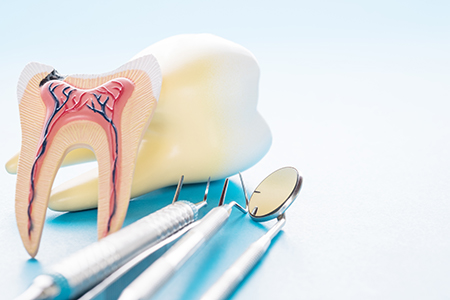If your dentist recommends a root canal, it’s understandable to feel uneasy — but don’t be alarmed. Modern root canal therapy is a routine, highly effective treatment that focuses on relieving pain, eliminating infection, and preserving your natural tooth whenever possible. In many cases it lets you keep a tooth that might otherwise need to be removed, helping you maintain chewing function and the appearance of your smile.
At the office of West Chicago Smiles, we combine careful diagnosis with gentle, contemporary techniques to make the process as comfortable and predictable as possible. Our team emphasizes clear communication so you know what to expect before, during, and after treatment.
Root canal treatment removes the inflamed or infected tissue inside a tooth while leaving the outer tooth structure intact. The goal is to stop the source of pain and stop an infection from spreading to surrounding bone and gum tissue. When successful, a treated tooth can continue to function for many years and often for the rest of a patient’s life.
Thanks to improved instruments and materials, the typical root canal visit is far less uncomfortable than people imagine. Local anesthesia numbs the area thoroughly, and many practices now use magnification and digital imaging to work with greater precision. This combination helps protect healthy structures while fully addressing the problem inside the tooth.
Choosing root canal therapy over extraction preserves your natural tooth and helps avoid the long-term consequences that can follow tooth loss, such as shifting teeth, altered bite patterns, and increased wear on neighboring teeth. In short, saving a tooth when feasible supports overall oral health and function.
Understanding that each case is unique, your dental provider will review the condition of the tooth, the extent of damage or infection, and the best restorative options to follow treatment. This planning helps ensure a durable result that blends with your smile and withstands normal chewing forces.

Not every toothache requires a root canal, but certain symptoms strongly indicate that the dental pulp is compromised. Persistent, intense pain — especially pain that wakes you at night or persists after removing hot or cold stimuli — often signals significant inflammation or infection within the tooth.
Other common warning signs include heightened sensitivity to temperature that lingers, discomfort when biting or chewing, noticeable darkening of a tooth, and swelling around the gums. A recent chip, crack, or blow to a tooth can also allow bacteria to reach internal tissues and trigger the need for treatment.
Some affected teeth display few or no symptoms but show clear signs of trouble on X-rays, such as areas of bone loss at the root tip. Because symptoms and radiographic findings do not always align, a careful clinical exam and targeted imaging are essential for an accurate diagnosis.
Below are common indicators that a tooth may require root canal therapy:
Pain that does not resolve with simple measures and that interferes with sleep or daily activities should prompt timely evaluation. Persistent pain is often the body’s signal that deeper tissues are affected.
If hot or cold foods and beverages produce a sharp sensation that lingers after the stimulus is gone, the pulp may be inflamed or compromised.
Discomfort upon pressure can indicate that the nerve has been irritated or that an infection has reached the surrounding tissues.
A change in color, particularly following trauma, can reflect internal changes in the tooth that warrant evaluation.
Structural damage can compromise the pulp and permit bacterial invasion. Even small fractures may require treatment to protect the tooth long-term.
Localized swelling or a recurring gum pimple (fistula) often indicates an underlying infection that needs professional care.
Infections that extend into the supporting bone can weaken attachment and produce mobility; root canal therapy can arrest the process and support healing.

Addressing pulp problems early simplifies treatment and improves outcomes. When infection or inflammation is treated before it spreads, there is less risk of extensive bone loss, swelling, or the need for more invasive procedures later on. Early care preserves options and generally shortens recovery.
Delaying treatment can allow bacteria to spread beyond the root tip and into surrounding bone, making the situation more complex and sometimes requiring surgical approaches or even extraction. Timely intervention reduces the chance of complications and helps restore oral comfort quickly.
Regular dental exams and X-rays are important because they can detect trouble before symptoms become severe. A tooth may appear normal externally while showing changes internally or around the root on imaging, so routine checkups remain a key part of prevention and early detection.
Root canal therapy follows a straightforward sequence designed to remove diseased tissue, disinfect the root canals, and seal the tooth to prevent reinfection. After numbing the area, the clinician isolates the tooth and creates a small opening to access the internal canals.
Using specialized instruments and often magnification, the canals are cleaned and shaped to remove bacteria and damaged tissue. Irrigating solutions help flush debris and disinfect areas that instruments cannot reach. Once clean and dry, the canals are filled with a biocompatible material to seal them.
The complexity of a root canal depends on factors such as tooth anatomy and whether an active infection is present. Some teeth can be treated in a single visit, while others benefit from staged treatment over two appointments to allow infection control and careful restoration planning.
After canal treatment, a permanent restoration — typically a crown — is recommended to restore strength and protect the remaining tooth structure from fracture. The restorative plan is coordinated with the endodontic steps to achieve a long-lasting, functional result.

Recovery following a root canal is usually straightforward. Mild soreness or sensitivity for a few days is common as surrounding tissues heal, and over-the-counter pain relievers typically manage any discomfort. If your clinician prescribes medication, follow the directions and complete the course as directed.
Protecting the treated tooth until it receives its final restoration is important. Temporary fillings are adequate for short periods, but a definitive crown or other permanent restoration prevents fractures and seals the tooth for long-term success. Your dentist will recommend the appropriate timing for this final step.
Maintaining excellent oral hygiene and attending regular dental checkups helps the treated tooth to remain healthy. With proper care, a root canal-treated tooth can function effectively for many years, often for a lifetime.
At the office of West Chicago Smiles, we prioritize patient education and clear follow-up instructions so you know how to care for your tooth after treatment. If you experience persistent pain, swelling, or other concerns after a procedure, contact our office promptly for an evaluation.
In summary, root canal therapy is a reliable way to eliminate pain, resolve infection, and preserve your natural tooth when the pulp has been damaged. If you have symptoms or concerns about a tooth, please contact us to learn more or to schedule an evaluation. Our team is here to answer your questions and guide you toward the treatment that best supports your oral health.
A root canal procedure is the best way to save a tooth that has been damaged by decay or injury and preserve your natural smile. The alternative is an extraction and treatment to replace the tooth. While at times a tooth is non-restorable and an extraction is the only option, when possible, it’s best to try and save your natural tooth. With proper care, a tooth with root canal therapy can serve your smile well for many years to come.
Despite lingering myths from before the age of modern dental anesthesia and technology, having a root canal procedure today is as routine and comfortable as visiting the dentist for a filling. While the procedure is performed under local anesthesia with your tooth completely numbed, we can also discuss options in dental sedation.
Whether the symptoms of a dental infection subside after a course of antibiotics, a draining abscess provides you with some temporary pain relief, or a tooth with radiographic evidence of pathology has not yet developed symptoms, it’s essential, before an infection worsens or occurs, to have a root canal procedure performed. In this way, the tooth can be disinfected, filled, and sealed to protect your health and avoid further problems.
If you have sustained a dental injury, have a toothache, jaw pain, swelling, or are experiencing any other unusual and uncomfortable oral symptoms, contact our office immediately for care. Dental problems that have not been evaluated and treated can significantly worsen, producing more severe damage and consequences for the involved teeth, your oral health, and even your overall wellbeing. Once you get in touch with our office, our friendly and compassionate office team will get you in for care at your earliest convenience.
While some root canal procedures can be completed in one visit, others may involve 2 or 3 appointments. How long it takes depends on various factors, including active infection, the number of canals in the tooth, and the tooth’s location or anatomy.
With a success rate that exceeds 95%, root canal therapy remains the most effective procedure to save a tooth in which the inner vital tissues have been damaged. However, as with all healthcare procedures, there are a small percentage of cases where the teeth become symptomatic a second time. The good news is that many of these teeth can still be saved with root canal retreatment or a minor surgical procedure known as an apicoectomy.
The best ways to maintain a tooth with root canal therapy are to get the proper restoration required to rebuild and protect the tooth, maintain proper oral hygiene, and schedule appointments for routine dental checkups and care.
Saving a tooth with root canal therapy is a wise investment that, in the long run, is typically less costly and invasive than having the tooth extracted and replaced with a fixed bridge or implant. As far as the exact cost of care, it can vary depending on which tooth is being treated. Many dental insurance plans provide coverage for root canal therapy. At the office of West Chicago Smiles, we do our best to optimize your dental benefits and minimize your out-of-pocket expenses. Our staff will answer all your questions about the cost of care and discuss all your payment options.
At the office of West Chicago Smiles, we use the latest technology and most effective methods of care to provide precise and gentle care. Our reputation for excellence is based upon a consistent record of achieving successful treatment outcomes while providing prompt, stress-free, and convenient treatment for every type of dental need.
